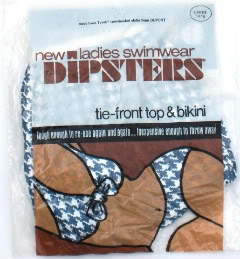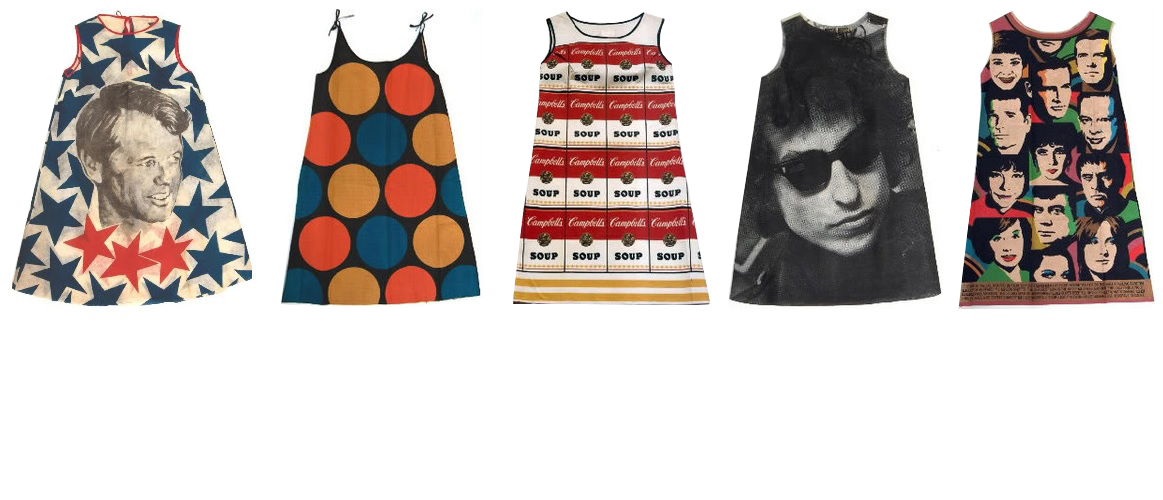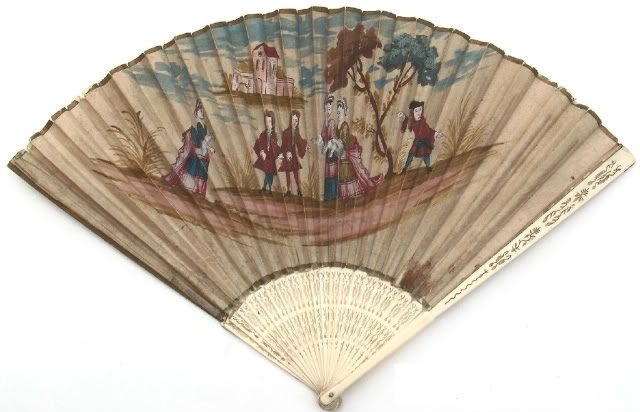
I will start with the earliest use of paper in fashionable dress and that is with fans in the 17th century. The idea of the folding paper fan was brought from the Far East and became a fashionable accessory in the early 1600s!
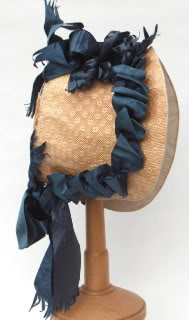
In the late 18th century a cardboard impressed and glazed to look like fancy straw work was used to make hats and bonnets. This example is from 1812.
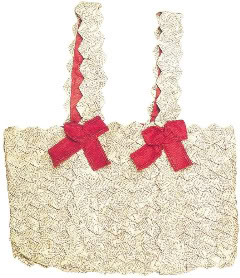
This image, courtesy of the Metropolitan Museum of Art, is a plaited newspaper purse from the 1860s. This was a common craft of the mid 19th century and was used to make bonnets as well as purses.
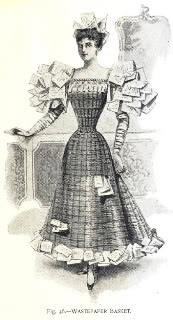
It was common to use paper for fancy dress balls beginning in the 1890s when crepe paper was first commercially marketed. This example from the 1895 edition of Fancy Dresses Described, however, uses the theme of a waste paper basket and includes old love letters sewn to the sleeves and crumpled paper to make a hat.
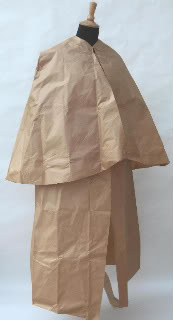
This American emergency raincoat made of brown kraft paper was patented in 1917, but during the First World War, many German citizens wore paper coats because of a lack of textiles which were blockaded from entering the country.

Crepe paper party dresses continued to be popular as cheap and fun costumes until the 1950s. This 1920s Halloween costume was surprisingly resiliant to tears unless it got wet, in which case it lost its strength and colour fastness.
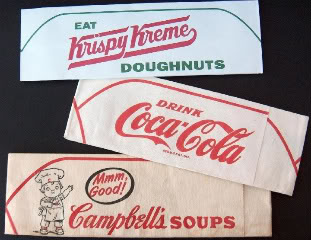
Using paper for non-costume reasons increased in the 1920s, with the introduction of paper collars and cuffs for men who were travelling and didn’t want to deal with laundry. Also, the soda jerk hat, based on the WW1 doughboy Garrison cap but in paper rather than khaki wool, was the first piece of clothing to be used as a billboard for companies to advertise their products.
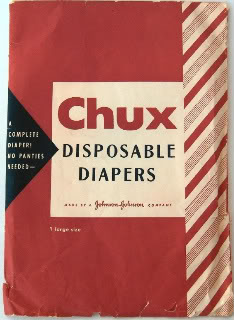
The other new development for paper in the 1920s was for hygiene products like facial tissues and tampons. Nobody thought of diapers however until after the Second World War. In about 1950 TWA commissioned Chux disposable diapers for their trans-atlantic passengers with babies.
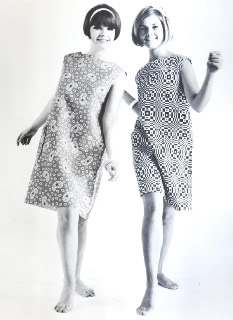
1966 Scott paper offered two different styles of paper dresses as a promotional gimmick. Scott unwittingly set off a fad that would rage for the next few years – paper dresses!
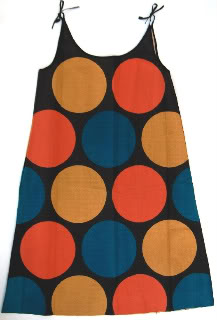
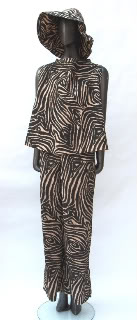
Two major producers of paper clothing were quick to follow up on Scott’s success. Mars of Asheville, North Carolina, a hosiery company, bought reams of white paper (consisting of two layers of paper sandwiching a rayon scrim for strength) from Kimberly Stevens and had it printed in colourful stripe, polka-dot and other patterns, and made up ‘A’ line dresses that were sold inexpensively through department stores and shops. James Sterling produced a slightly higher end product with more complicated patterns including a two piece pant suit with matching hat in 1966.
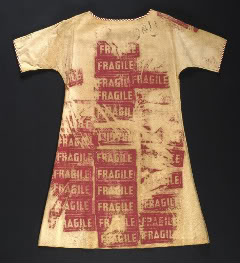
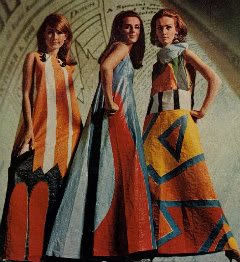
Commercially produced paper dresses didn’t kill creativity. A paper dress ball held at the Wadsworth Atheneum in the fall of 1966 encouraged party-goers to have designers create couture one-offs for the event; some of the results were pictured in Life Magazine. Mars of Asheville also offered a plain white dress in the fall of 1966 that came with a water colour paint set. To promote this product Mars hired Andy Warhol to design one at a happening. He stencilled ‘fragile’ onto the dress while a model wore it and signed the dress ‘Dali’. The resulting garment, seen here, was donated to the Brooklyn Museum of Art.
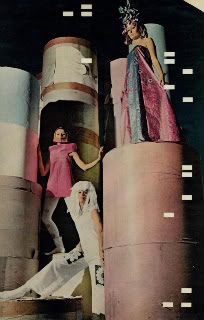
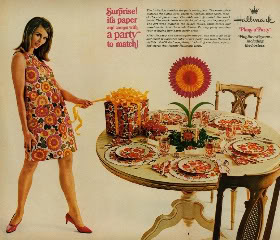
By the spring of 1967 paper dresses were a full flung fad. At Expo 67 in Montreal seen above, paper dresses were featured in the pulp and paper pavillion. Hallmark picked up on the trend and produced paper dresses with matching paper plates, gift wrap, napkins, placemats and other party paraphernalia for a complete party theme!
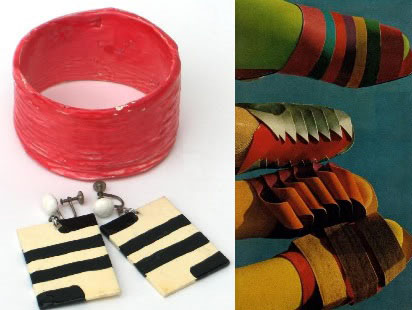
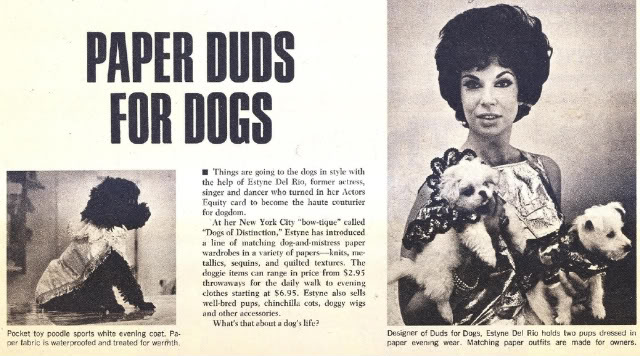
By the end of 1967 the paper fad had expanded to include paper jewellery (including papier mache), shoes, and even duds for dogs!
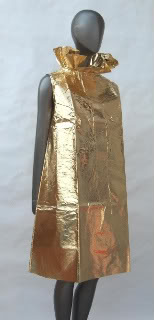
Designers specializing in paper explored the possibilities of different types of paper garments including Elisa Daggs who was hired to create stewardess uniforms of paper including one in gold foil (a new type of paper recently introduced in the mid 1960s and used widly by fast food restaurants…) for transatlantic service from New York to Paris. The Indian paper sari, also designed by Elisa Daggs, was made for Air India but not for wear by stewardesses, but rather as a promotional item.
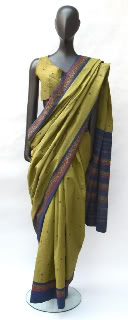
Probably the most famous paper dress ever is this one used as a promotion by Campbell’s Soup and called the ‘Souper’ dress in 1967. It could be purchased with some proofs of purchase of Campell’s soup and money for postage. Although the inspiration for the design was taken from Warhol’s use of the Campbell’s Soup label in his early 60s Graphic Art style works, Warhol did not design this dress or have any involvement in its creation. In fact, Warhol’s use of the label for his own artwork and Campbell’s use of Warhol’s style for their own product would today probably end up in a court battle over copyright infringement — for both parties!
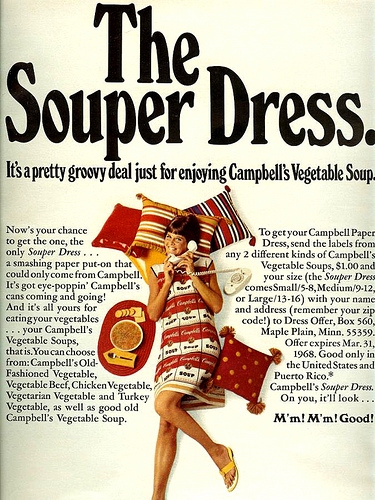
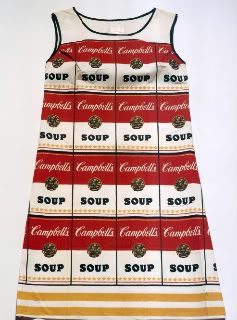
Before T-shirt art, the paper dress became a billboard for advertisers, sometimes very artistically such as in this silk screen print of Hollywood faces to be seen in upcoming film releases in 1968, and sometimes patriotically, as seen in this dress for the democratic campaign of Bobby Kennedy in 1968.
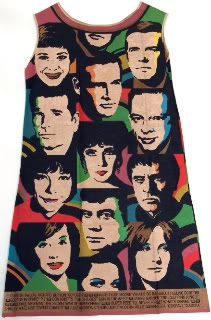
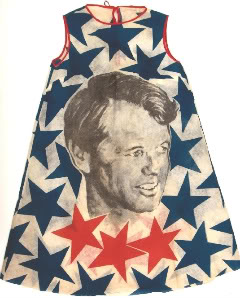
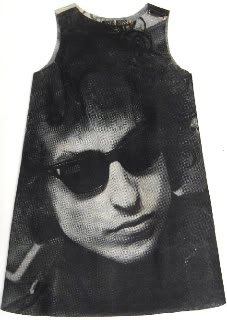
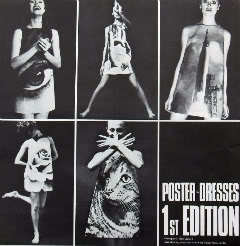
As early as 1967 there was a serious shortage of paper for making paper garments and alternatives were experimented with including Fibron, a pressed rayon fibre with tiny perforations allover (still made today as J-CLoths and Handi-Wipes). These English made dresses used Fibron instead of paper, however, the market for which they were made was identified as ‘disposables’, so materials ranged from paper and Fibron to spun polyester Reemay and even light plastic dresses.
The London Poster series was supposed to be the first of many but with the exception of Bob Dylan, another series was never produced by this company.
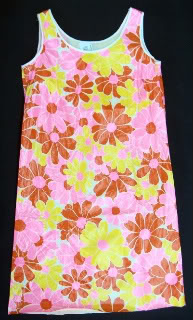
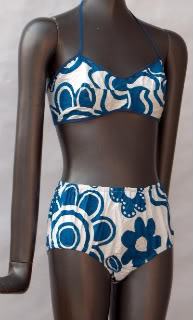
The flowered dress is a plasticized reemay, disposable perhaps, but it could take a thousands years to break down!
Tyvek was the other new wonder ‘disposable’ material of the age and was used for making bathing suits. These new materials however were symptomatic of the demise of the paper dress trend. By late 1968 paper, fibron, reemay, tyvek and all other disposable material garments were languishing on store shelves and magazines with offers of premiums and give-aways of disposable garments dwindled with each passing month.
The Hippie movement with its strong anti-pollution message was effectively changing the late 1960s from one of self-consicous space-age modernity into a more planet friendly back to nature awareness — the conflict between these two extremes persist today!
In the late 1970s disposable tyvek bathing suits were once again being offered at hotels which now often had year round heated indoor swimming pools. Travellers not yet used to this luxury would arrive without a bathing suit. Dipsters brand came to the rescue for a few dollars each!
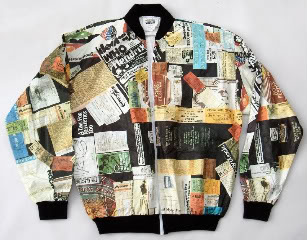
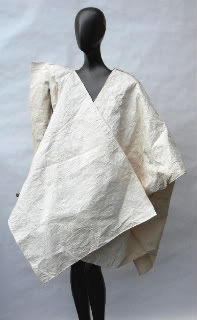
In the 1980s there was some experimentation with Tyvek. Spearheaded by Issey Miyake, he liked the papery qualities of Tyvek which was similar to the traditional Japanese oiled paper used for making rain capes and parasols. His 1985 coat seen here explored the modern use of Tyvek in fashion but for the most part it was traditionally cut jackets that were the most successful on the market. They were especially popular for those who went to open air concerts or sporting events unprepared for a change in the weather.
Written by Jonathan Walford, 2008
